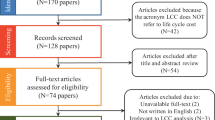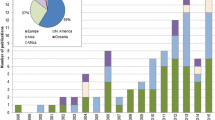Abstract
Purpose
The paper provides an empirical assessment of an uninterruptible power supply (UPS) system based on hydrogen technologies (HT-UPS) using renewable energy sources (RES) with regard to its environmental impacts and a comparison to a UPS system based on the internal combustion engine (ICE-UPS).
Methods
For the assessment and comparison of the environmental impacts, the life-cycle assessment (LCA) method was applied, while numerical models for individual components of the UPS systems (electrolyser, storage tank, fuel cell and ICE) were developed using GaBi software. The scope of analysis was cradle-to-end of utilisation with functional unit 1 kWh of uninterrupted electricity produced. For the life-cycle inventory analysis, quantitative data was collected with on-site measurements on an experimental system, project documentation, GaBi software generic databases and literature data. The CML 2001 method was applied to evaluate the system’s environmental impacts. Energy consumption of the manufacturing phase was estimated from gross value added (GVA) and the energy intensity of the industry sector in the manufacturer’s country.
Results and discussion
In terms of global warming (GW), acidification (A), abiotic depletion (AD) and eutrophication (E), manufacturing phase of HT-UPS accounts for more than 97 % of environmental impacts. Electrolyser in all its life-cycle phases contributes above 50 % of environmental impacts to the system’s GW, A and AD. Energy return on investment (EROI) for the HT-UPS has been calculated to be 0.143 with distinction between renewable (roughly 60 %) and non-renewable energy resources inputs. HT-UPS’s life-cycle GW emissions have been calculated to be 375 g of CO2 eq per 1 kWh of uninterruptible electric energy supplied. All these values have also been calculated for the ICE-UPS and show that in terms of GW, A and AD, the ICE-UPS has bigger environmental impacts and emits 1,190 g of CO2 eq per 1 kWh of uninterruptible electric energy supplied. Both systems have similar operation phase energy efficiency. The ICE-UPS has a higher EROI but uses almost none RES inputs.
Conclusions
The comparison of two different technologies for providing UPS has shown that in all environmental impact categories, except eutrophication, the HT-UPS is the sounder system. Most of HT-UPS’s environmental impacts result from the manufacturing phase. On the contrary, ICE-UPS system’s environmental impacts mainly result from operational phase. Efficiency of energy conversion from electricity to hydrogen to electricity again is rather low, as is EROI, but these will likely improve as the technology matures.












Similar content being viewed by others
References
Anderson D, Leach M (2004) Harvesting and redistributing renewable energy: on the role of gas and electricity grids to overcome intermittency through the generation and storage of hydrogen. Energ Policy 32:1603–1614
Barnhart CJ, Dale M, Brandt AR, Benson SM (2013) The energetic implications of curtailing versus storing, solar- and wind-generated electricity. Energy Environ Sci 6:2804–2810
Centre of Excellence for Low-Carbon Technologies (2010) Demonstration project 2—hydrogen technologies in advanced energy supply, <http://www.conot.si/eng/index.php/development-programs/102-rrp-9-demonstration-project-2-hydrogen-technologies-in-advanced-energy-supply.html>, [accessed 5 June 2013]
Cetinkaya E, Dincer I, Naterer G (2012) Life cycle assessment of various hydrogen production methods. Int J Hydrog Energy 37:2071–2080
Cicconardi SP, Jannelli E, Spazzafumo G (1997) Hydrogen energy storage: hydrogen and oxygen storage subsystems. Int J Hydrog Energy 22(9):897–902
Dufour J, Serrano DP, Gálvez JL, Moreno J, Garcia C (2009) Life cycle assessment of processes for hydrogen production. Environmental feasibility and reduction of greenhouse gases emissions. Int J Hydrog Energy 39:1370–1376
El-Shatter TF, Eskander MN, El-Hagry MT (2002) Hybrid PV/fuel cell system design and simulation. Renew Energy 27:479–485
El-Shatter TF, Eskander MN, El-Hagry MT (2006) Energy flow and management of a hybrid wind/PV/fuel cell generation system. Energy Convers Manag 47:1264–1280
EPRIsolutions (2001) Uninterruptible power supply using a PEM fuel cell—design, construction and test, Palo Alto, CA, USA
Glavina U (2008) Usage of extracted hydrogen from wood biomass in fuel cell cogeneration systems. Master Thesis, University of Ljubljana, Faculty of Mechanical Engineering
Guinée JB (ed) (2002) Handbook on life cycle assessment. Kluwer Academic Publishers, Dordrecht
Hart D (2000) Sustainable energy conversion—fuel cells—the competitive option. J Power Sources 86:23–27
Heijungs R (2014) Ten easy lessons for good communication of LCA. Int J Life Cycle Assess 19(3):473–476
Hydrogenics (2011), HySTAT® hydrogen generators, industrial brochure, <http://www.hydrogenics.com/docs/default-source/pdf/2-1-1-industrial-brochure_english.pdf?sfvrsn=2>, [accessed June 2014]
Hussain MM, Dincer I, Li X (2007) A preliminary life cycle assessment of PEM fuel cell powered automobiles. Appl Therm Eng 27:2294–2299
Hwang J-J et al (2013) Lifecycle performance assessment of fuel cell/battery electric vehicles. Int J Hydrog Energy 38:3433–3446
International Energy Agency (IEA) (2011) World energy outlook 2011, Paris
International Organisation for Standardisation (2006a) ISO 14040—environmental management—life cycle assessment—principle and framework
International Organisation for Standardisation (2006b) ISO 14044—environmental management—life cycle assessment—requirements and guidelines
Jensterle M (2012) Evaluation of hydrogen technologies in advanced energy systems by methods of life cycle analysis, Master Thesis, University of Ljubljana, Faculty of Mechanical Engineering
Koroneus C, Dompros A, Roumbas G, Moussiopoulos N (2004) Life cycle assessment of hydrogen fuel production processes. Int J Hydrog Energy 29:1443–1450
Lacko R, Drobnič B, Leban M (2013) Hydrogen technologies in self-sufficient energy system with renewables. J Energy Technol 6(3):11–24
Lacko R, Drobnič B, Sekavčnik M, Mori M (2014) Hydrogen energy system with renewables for isolated households: the optimal system design, numerical analysis and experimental evaluation. Energy Build 80:106–113
Lotrič A, Sekavčnik M, Kunze C, Spliethoff H (2011) Simulation of water-gas shift membrane reactor for integrated gasification combined cycle plant with CO2 capture. J Mech Eng 57(12):911–926
Milewski J, Miller A, Badyda K (2010) The control strategy for high temperature fuel cell hybrid systems. Online J Electron Electr Eng 2(4):331–335
Mori M, Mržljak T, Drobnič B, Sekavčnik M (2013) Integral characteristics of hydrogen production in alkaline electrolysers. J Mech Eng 59(10):585–594, ISSN 0039–2480
Moomaw W, Burgherr P, Heath G, Lentzen M, Nyboer J, Verbruggen A (2011) Special report on renewable energy sources and climate change mitigation, Annex II. Cambridge University Press, Cambridge, United Kingdom and New York, NY, USA
Morton O (2006) Solar energy: a new day dawning? Silicon Valley sunrise. Nature 443:19–22
Odyssee indicators (2010) Energy efficiency indicators in Europe, <http://www.odyssee-indicators.org/online-indicators/>, [accessed May 2013]
Ogden J (1999) Prospects for building a hydrogen energy infrastructure. Annu Rev Energy Environ 24:227–279
Patyk A, Bachmann TA, Brisse A (2013) Life cycle assessment of H2 generation with high temperature electrolysis. Int J Hydrog Energy 38:3865–3880
PE International (2012) Gabi database, <http://www.gabi-software.com/support/gabi/gabi-lci-documentation/data-sets-by-database-modules/professional-database/>, [accessed June 2013]
Pehnt M (2001) Life-cycle assessment of fuel cell stacks. Int J Hydrog Energy 10:91–101
Pereira SR, Coelho MC (2013) Life cycle analysis of hydrogen—a well-to-wheels analysis for Portugal. Int J Hydrog Energy 38:2029–2038
Rooijen Jv. (2006) A life cycle assessment of the PureCell stationary fuel cell system: providing a guide for environmental improvement. A report of the Center for Sustainable Systems, Report No. CSS06-09, <http://css.snre.umich.edu/css_doc/CSS06-08.pdf>, [accessed June 2014]
Sherif S, Barbir F, Veziroglu TN (2005) Wind energy and the hydrogen economy—review of the technology. Sol Energy 78:647–660
Slovenian Environment Agency (2008) Test reference year, Ljubljana, 2008
Smitkova M, Janíček F, Riccardi J (2011) Life cycle analysis of processes for hydrogen production. Int J Hydrog Energy 36:7844–7851
Sovacool BK (2008) Valuing the greenhouse gas emissions from nuclear power: a critical survey. Energ Policy 36:2940–2953
Staffel I, Ingram A (2010) Life cycle assessment of an alkaline fuel cell CHP system. Int J Hydrog Energy 35:2491–2505
Vielstich W, Lamm A, Gasteiger HA (eds) (2003) Life-cycle analysis of fuel cell system components. In: Handbook of fuel cells—fundamentals, technology and applications, Volume 4, Chapter 13. Chichester: John Wiley & Sons
Wee J-H (2007) Applications of proton exchange membrane fuel cell systems. Renew Sustain Energy Rev 11:1720–1738
White P, Driscoll D, Cowan S. Life-cycle impact assessment of a one kW fuel cell system (2001), <http://www.orb-design.com/fuelcel.pdf>, [accessed June 2014]
Acknowledgments
Part of this work was carried out within the Centre of Excellence for Low-Carbon Technologies (CO NOT), Hajdrihova 19, 1000 Ljubljana, Slovenia. We also wish to acknowledge suggestions provided by the reviewers.
Author information
Authors and Affiliations
Corresponding author
Additional information
Responsible editor: Shabbir Gheewala
Rights and permissions
About this article
Cite this article
Mori, M., Jensterle, M., Mržljak, T. et al. Life-cycle assessment of a hydrogen-based uninterruptible power supply system using renewable energy. Int J Life Cycle Assess 19, 1810–1822 (2014). https://doi.org/10.1007/s11367-014-0790-6
Received:
Accepted:
Published:
Issue Date:
DOI: https://doi.org/10.1007/s11367-014-0790-6




